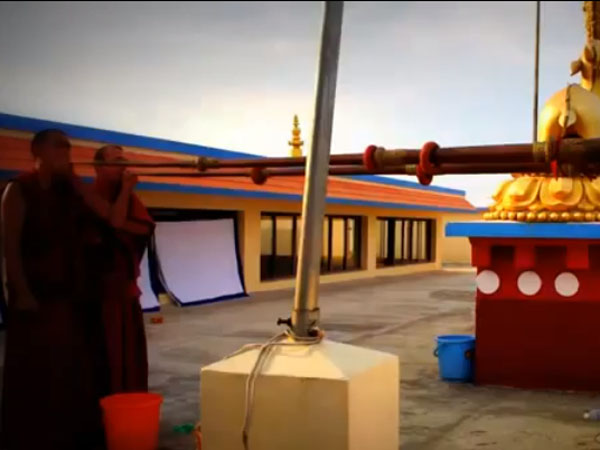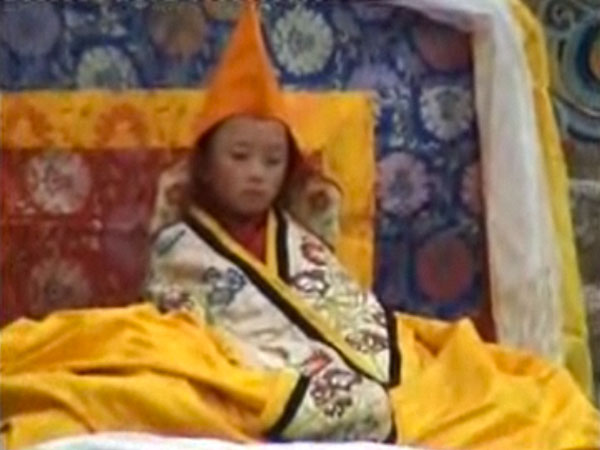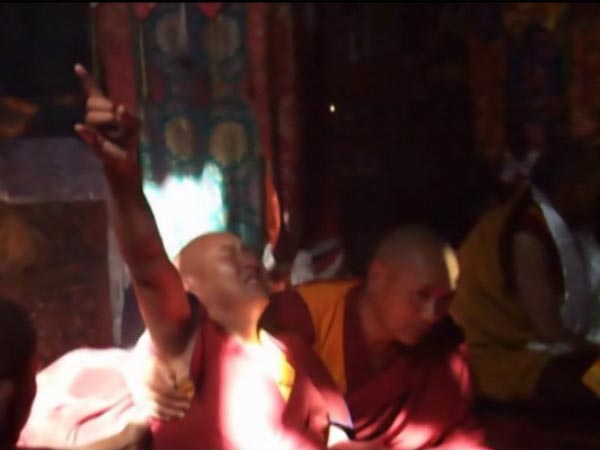FEATURES
| NECHUNG : THE STATE ORACLE OF TIBET | | Print | |
 New Year prophecy of the Nechung oracle Like many ancient civilizations of the world, the phenomenon of oracles remains an important part of the Tibetan way of life. Tibetans rely on oracles for various reasons. The purpose of the oracles is not just to foretell the future. They are called upon as protectors and sometimes used as healers. However, their primary function is to protect the Buddha Dharma and its practitioners. In the Tibetan tradition, the word oracle is used for a spirit which enters those men and women who act as mediums between the natural and the spiritual realms. The mediums are, therefore, known as kuten, which literally means, "the physical basis." Readers' Comments
In early times, it is believed that there were hundreds of oracles throughout Tibet. Today, only a few survive, including those consulted by the Tibetan government. Of these, the principal one is the Nechung oracle. Through him manifests Dorje Drak-den (Nechung), the principal Protector divinity of the Tibetan government and the Dalai Lama. It is because of this that Nechung Kuten is given the rank of a deputy minister in the exiled Tibetan government hierarchy. In his autobiography, Freedom in Exile, His Holiness the Dalai Lama writes: "For hundreds of years now, it has been traditional for the Dalai Lama, and the Government, to consult Nechung during the New Year festivals. In addition, he might well be called upon at other times if either have specific queries. I myself have dealings with him several times a year. "This may sound far-fetched to twentieth-century western readers. Even some Tibetans, mostly those who consider themselves progressive, have misgivings about my continued use of this ancient method of intelligence gathering. "But I do so for the simple reason that as I look back over the many occasions when I have asked questions of the oracle, on each one of them time has proved that his answer was correct. This is not to say that I rely solely on the oracle's advice. I do not. I seek his opinion in the same way as I seek the opinion of my Cabinet and just as I seek the opinion of my own conscience. I consider the gods to be my upper house. The Kashag constitutes my lower house. "Like any other leader, I consult both before making a decision on affairs of state. And sometimes, in addition to Nechung's counsel, I also take into consideration certain prophecies. "In one respect, the responsibility of Nechung and the responsibility of the Dalai Lama towards Tibet are the same, though we act in different ways. My task, that of leadership, is peaceful. His, in his capacity as protector and defender, is wrathful. "However, although our functions are similar, my relationship with Nechung is that of commander to lieutenant: I never bow down to him. It is for Nechung to bow to the Dalai Lama. Yet we are very close, friends almost. When I was small, it was touching. Nechung liked me a lot and always took great care of me. For example, if he noticed that I had dressed carelessly or improperly, he would come over and rearrange my shirt, adjust my robe and so on. "Nechung has always shown respect for me. Even when his relations with the Government have deteriorated, as they did during the last few years of the Regency, he invariably responds enthusiastically whenever asked anything about me. At the same time, his replies to questions about government policy can be crushing. Sometimes he just responds with a burst of sarcastic laughter. I well remember a particular incident that occurred when I was about fourteen. Nechung was asked a question about China. "Rather than answer it directly, the Kuten turned towards the East and began bending forward violently. It was frightening to watch, knowing that this movement combined with the weight of the massive helmet he wore on his head would be enough to snap his neck. He did it at least fifteen times, leaving no one in any doubt about where the danger lay. "Dealing with Nechung is by no means easy. It takes time and patience during each encounter before he will open up. He is very reserved and austere, just as you would imagine a grand old man of ancient times to be. Nor does he bother with minor matters: his interest is only in the larger issues, so it pays to frame questions accordingly. He also has definite likes and dislikes, but he does not show them very readily. "Nechung has his own monastery in Dharamsala, but usually he comes to me. On formal occasions, the Kuten is dressed in an elaborate costume consisting of several layers of clothing topped by a highly ornate robe of golden silk brocade, which is covered with ancient designs in red and blue and green and yellow. On his chest he wears a circular mirror which is surrounded by clusters of turquoise and amethyst, its polished steel flashing with the Sanskrit mantra corresponding to Dorje Drakden. "Before the proceedings begin, he also puts on a sort of harness, which supports four flags and three victory banners. Altogether, this outfit weighs more than seventy pounds and the medium, when not in trance, can hardly walk in it.
New Year prophecy of the Nechung oracle  The Tibetan state oracle "The ceremony begins with chanted invocations and prayers, accompanied by the urgings of horns, cymbals and drums. After a short while, the Kuten enters his trance, having been supported until then by his assistants, who now help him over to a small stool set before my throne. Then, as the first prayer cycle concludes and the second begins, his trance begins to deepen. At this point, a huge helmet is placed on his head. This item weighs approximately 30 pounds, though in former times it weighed over eighty. "Now the kuten's face transforms, becoming rather wild before puffing up to give him an altogether strange appearance, with bulging eyes and swollen cheeks. His breathing begins to shorten and he starts to hiss violently. Then, momentarily, his respiration stops. At this point the helmet is tied in place with a knot so tight that it would undoubtedly strangle the Kuten if something very real were not happening. The possession is now complete and the mortal frame of the medium expands visibly. "Next, he leaps up with a start and, grabbing a ritual sword from one of his attendants, begins to dance with slow, dignified, yet somehow menacing, steps. He then comes in front of me and either prostrates fully or bows deeply from the waist until his helmet touches the ground before springing back up, the weight of his regalia counting for nothing. The volcanic energy of the deity can barely be contained within the earthly frailty of the kuten, who moves and gestures as if his body were made of rubber and driven by a coiled spring of enormous power. "There follows an interchange between Nechung and myself, where he makes ritual offerings to me. I then ask any personal questions I have for him. After replying, he returns to his stool and listens to questions put by members of the Government. Before giving answers to these the Kuten begins to dance again, thrashing his sword above his head. He looks like a magnificent, fierce Tibetan warrior chieftain of old. "As soon as Dorje Drakden has finished speaking, the Kuten makes a final offering before collapsing, a rigid and lifeless form, signifying the end of the possession. Simultaneously, the knot holding his helmet in place is untied in a great hurry by his assistants, who then carry him out to recover whilst the ceremony continues. "Surprising as it may seem, the oracles replies to questions are rarely vague. As in the case of my escape from Lhasa, he is often very specific. But I suppose that it would be difficult for any scientific investigation either to prove or disprove conclusively the validity of his pronouncements. The same would surely be true of other areas of Tibetan experience, for example the matter of Tulkus (reincarnate Lamas)."
The earliest account of Nechung can be traced back to his relationship with the great Indian Spiritual King Kunchog Bhang, who was an emanation of Arya Avalokiteshvara. In 750 AD, the Dharma protector had a special connection with the Tibetan King Tri-Song Deu-Tsan. However, it was only in 1544 AD that for the first time the spirit of Nechung was possessed in a human being. Thus, Drag Trang-Go-Wa Lobsang Palden became the first medium of Nechung. During the reign of the Great Fifth Dalai Lama, Gangkyi-Pa Tsewang Pelbar was recognized as the fourth medium of Nechung or Tibets State Oracle. At that time, Nechung Monastery had around 50 monks.
Venerable Thupten Ngodup  Nechung Kuten After the passing away of the Great Fifth Dalai Lama, the Regent Desi Sangye Gyatso (1653-1705) ruled Tibet, and Kongpo Lobsang Gyatso succeeded the previous medium. It was during this period that Nechung Monastery flourished extensively. The sixth medium, Ngawang Gyatso, brought some major changes in the liturgical tradition of Nechung Monastery. He instituted the entire cycle of practices comprising of the retreat, the accomplishment, and the ritual tradition of Sog-Khang Drub-Pa Chen-Mo (Grand immutable Life Shelter), a primary meditational retreat practice on Hayagriva and Gyal-Po Ku-Nga (Five Dharma Kings), and the complimentary ritual fire offering, invocation rite and the cross-thread rituals (Doe) and longevity rites, as are explained in Shal-Treng Kar-Poi Gyud (White Crystal Tantra). The medium also introduced Sog-Khang Nam-Shad Lak-Pe Kun-Shay (Omniscience Through Reading the Commentary of the Life Shelter) and others. The Seventh Medium, Tsangyang Tamdin, also known as Lobsang Tashi, instituted the rites of Dag-Dun Bum-Sum (Self-generation, Generation In-front and Vase-generation) of the Thirteen Deities of Yamantaka, as well as the grand consecration rite of Ge-Leg Char-Beb (Auspicious Shower). Lhalungpa Shakya Yarphel became the eighth medium of Nechung during the reign of the Tenth Dalai Lama, Tsultrim Gyatso (1816-1837) and remained so, until the first part of the 13th Dalai Lama's rule. During this time, Nechung Monastery then had 115 monks. This medium of Tibet's State Oracle restored Zhi-sum (Three Basic Rites) of the monastic discipline. He also founded retreat cells on the hills of Lhalung, where there used to be a meditation cell belonging to Lhalung Pelgyi Dorjee, the Buddhist monk responsible for killing Lang Dharma, the anti-Buddhist king. The medium Lhalungpa Shakya Yarphel built Pehar Chog (chapel) at the old Me-Ru Monastery. It was during his time that Nechung Monastery received Dra-Chyis Phun-Rab estate and Min-Drug estate and others. Drapchi Phunrabpa Tsering Palden also voluntarily offered the exquisite golden roof placed atop Nechung Monastery and the 21 gold-coated statues of Tara, a human-sized statue of Avalokiteshvara Sem-Nyid Ngal-So, as well as a silver cascade altar containing two statues made of Sha-li bronze and Zhi-Khim bronze. For the assembly hall below, he offered a special Guru Nang-Srid Zil-Non statue, and a pair of gold butter lamp pots, known as Kal-Zang Chod-Kong (Auspicious Butter Lamp Pot) that could each retain about four kilograms of butter. In short, Drapchi Phunrabpa Tsering Palden offered all his wealth, property and belongings to Nechung Monastery as a resource for the conduct of future ceremonial activities. During the same period, Barn-Rim Monastery in Kongpo region also came under Nechung's administrative control. The general masses serving the government estates voluntarily offered a portion of their taxes to the government as offerings to Nechung Monastery and requested the monastery to accept them as its subjects. Besides, a small monastery known as Lha-Ri Zim-Bug or Pad-Me Zim-Bug of Phung-Po Ri-Bo-Che in the Tsang region and two nunneries located in Ki-Lung area of Phenpo also became branch monasteries of Nechung Monastery. Lobsang Sonam of Kham became the ninth medium of Tibet's Nechung Oracle, and Lhalungpa Gyaltsen Tharchin became the 10th medium. Lobsang Sonam was reinstalled as the 11th medium. While he was in trance, the State Oracle pronounced a prayer for the speedy return of the 13th Dalai Lama. After the demise of the Great 13th Dalai Lama, Lobsang Namgyal (ca. 1935) of Derbag, near Nechung Monastery, became the 12th medium. He accompanied the Regent, Reting Rinpoche, to Samye Monastery at the Samye restoration ceremony. When the Tibetan government requested him to perform a trance in the presence of Guru Nga-Dra-Mas statue, the oracle through him made prophesies regarding the search for the reincarnation of the 13th Dalai Lama. The oracle left a resource for the conduct of ceremonial rituals at Nechung Monastery, especially for the conduct of Avalokiteshvara Dro-Wa Kun-Drol rituals. In 1945, Lobsang Jigme of Lhasa was publicly proclaimed to be the new and the thirteenth medium of Tibet's State Oracle. He became the first Nechung kuten (medium) to rise from the ranks of Nechung Monastery. His predecessors had all come from elsewhere. In 1949, during a trance performed at Tsom-Chen Nyi-Od (Sunny Hall), the oracle gave clear prophesies concerning the spiritual and temporal issues relating to Tibet. Likewise, during a trance performance at the main hall of Drepung Monastery, it left clear-cut prophesies to remove obstacles and hindrances to the life of the present Dalai Lama, Tenzin Gyatso. The medium also offered costumes and built a special altar for the Thousand golden statues of the Buddha and the 21 Taras housed in Nechung Monastery's middle storey called Zam-Ling Zim-Chung (Universal Chamber). During the 1959 Tibetan national uprising against China's invasion and occupation of Tibet, the State Oracle, Nechung, communicating through his medium Venerable Lobsang Jigme, left very clear prophesies about the escape route to be followed by His Holiness the Dalai Lama into exile in India. Venerable Losang Jigme, who also escaped to India, following the Chinese occupation of Tibet, continued to serve as the medium of Tibet's State Oracle until he passed away in Dharamsala on April 26, 1984. The present and the 14th medium of the State Oracle is Venerable Thubten Ngodup. Born in 1957 in Phari, Tibet, he and his family fled the country after the Chinese invasion. He came to Dharamsala in 1969 and joined Nechung Monastery in 1971. The first time Venerable Thubten Ngodup was possessed by Nechung's spirit was on March 31, 1987. After this, His Holiness the Dalai Lama privately had Venerable Thubten Ngodup perform a trance in his presence, during which His Holiness tested him in accordance with tradition. Later on, a number of trances were requested and he also went on a retreat of Hayagriva, the meditational deity Padma Wangchen and of Guru Rinpoche's La-Drub (Self-generation) practice. On September 4, 1987, Venerable Thubten Ngodup was recognized by His Holiness the Dalai Lama as the new medium of the State Oracle of Tibet and an official ceremony to this effect was held at Nechung Monastery in Dharamsala, the seat of the Tibetan government in exile. Source : http://www.bibliotecapleyades.net
|
Comments
OTHER FEATURES
- GADEN KACHOE SHING, USA
- TUGS BAYASGALANT NUNNERY
- TRIJANG CHOCKTRUL RINPOCHE LEADS VAJRA YOGINI FIRE PUJA
- GESHE YESHE WANGCHUK AND HIS HEART DISCIPLE, TRICHEN LAMA
- SUPPORTING THE GROWTH OF DORJE SHUGDEN IN SOUTH AFRICA









